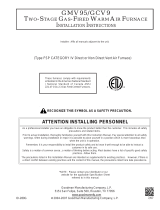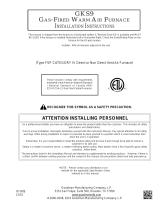
© 2009 Trane All Rights Reserved 18-CD19D5-25
Installer’s Guide
SAFETY SECTION
The following safety practices and precautions must be
followed during the installation, servicing, and opera-
tion of this furnace.
1. Use only with the type of gas approved for this fur-
nace. Refer to the furnace rating plate.
2. Install this furnace only in a location and position as
specified in “Location and Clearances” (page 4), of
these instructions.
3. Provide adequate combustion and ventilation air to
the furnace space as specified in “Air for Combus-
tion and Ventilation” (pages 8-9), of these instruc-
tions.
4. Combustion products must be discharged outdoors.
Connect this furnace to an approved vent system
only, as specified in the “Venting” section (pages 16-
26), of these instructions.
5. Never test for gas leaks with an open flame. Use a
commercially available soap solution made specifi-
cally for the detection of leaks to check all connec-
tions, as specified in “Gas Piping” (page 32), of these
instructions.
6. Always install the furnace to operate within the
furnace’s intended temperature-rise range with a
duct system which has an external static pressure
within the allowable range, as specified on the unit
rating plate. Airflow with temperature rise for cfm
versus static is shown in the Service Facts accom-
panying this furnace.
7. When a furnace is installed so that supply ducts
carry air circulated by the furnace to areas outside
the space containing the furnace, the return air
shall also be handled by a duct(s) sealed to the fur-
nace casing and terminating outside the space con-
taining the furnace.
8. A gas-fired furnace for installation in a residential
garage must be installed as specified in “Location
and Clearances” section (page 4), of these instruc-
tions.
9. The furnace may be used for temporary heating of
buildings or structures under construction only
when the following conditions have been met:
a. The furnace venting system must be complete
and installed per manufacturers instructions.
b. The furnace is controlled only by a room ther-
mostat (no field jumpers).
c. The furnace return air duct must be complete
and sealed to the furnace and clean air filters
are in place.
d. The furnace input rate and temperature rise
must be verified to be within nameplate mark-
ing.
e. 100% of the furnace combustion air require-
ment must come from outside the structure.
WARNING
!
CARBON MONOXIDE POISONING HAZARD
Failure to follow the steps outlined below for each appli-
ance connected to the venting system being placed into
operation could result in carbon monoxide poisoning or
death.
The following steps shall be followed for each appliance
connected to the venting system being placed into op-
eration, while all other appliances connected to the vent-
ing system are not in operation:
1. Seal any unused openings in the venting system.
2. Inspect the venting system for proper size and hori-
zontal pitch, as required in the National Fuel Gas
Code, ANSI Z223.1/ NFPA 54 or the CAN/ CGA B149
Installation Codes and these instructions. Determine
that there is no blockage or restriction, leakage, cor-
rosion and other deficiencies which could cause an
unsafe condition.
3. As far as practical, close all building doors and win-
dows and all doors between the space in which the
appliance(s) connected to the venting system are lo-
cated and other deficiencies which could cause an
unsafe condition.
4. Close fireplace dampers.
5. Turn on clothes dryers and any appliance not con-
nected to the venting system. Turn on any exhaust
fans, such as range hoods and bathroom exhausts,
so they are operating at maximum speed. Do not op-
erate a summer exhaust fan.
6. Follow the lighting instructions. Place the appliance
being inspected into operation. Adjust the thermo-
stat so appliance is operating continuously.
f. The furnace return air temperature range is
between 55 and 80 degrees Fahrenheit.
g. Clean the furnace, duct work, and components
upon substantial completion of the construction
process, and verify furnace operating conditions
including ignition, input rate, temperature rise
and venting, according to the manufacturer's
instructions.
10. This product must be gas piped by a Licensed
Plumber or Gas Fitter in the Commonwealth of Mas-
sachusetts.
Safety signal words are used to designate a degree or
level of seriousness associated with a particular hazard.
The signal words for safety markings are DANGER,
WARNING, and CAUTION.
a. DANGER indicates an imminently hazardous situa-
tion which, if not avoided, will result in death or seri-
ous injury. This signal word is limited to the most ex-
treme situations.
b. WARNING indicates a potentially hazardous situation
which, if not avoided, could result in death or serious
injury.
c. CAUTION indicates a potentially hazardous situation
which, if not avoided, may result in minor or moder-
ate injury. It is also used to alert against unsafe prac-
tices and hazards involving only property damage.





















